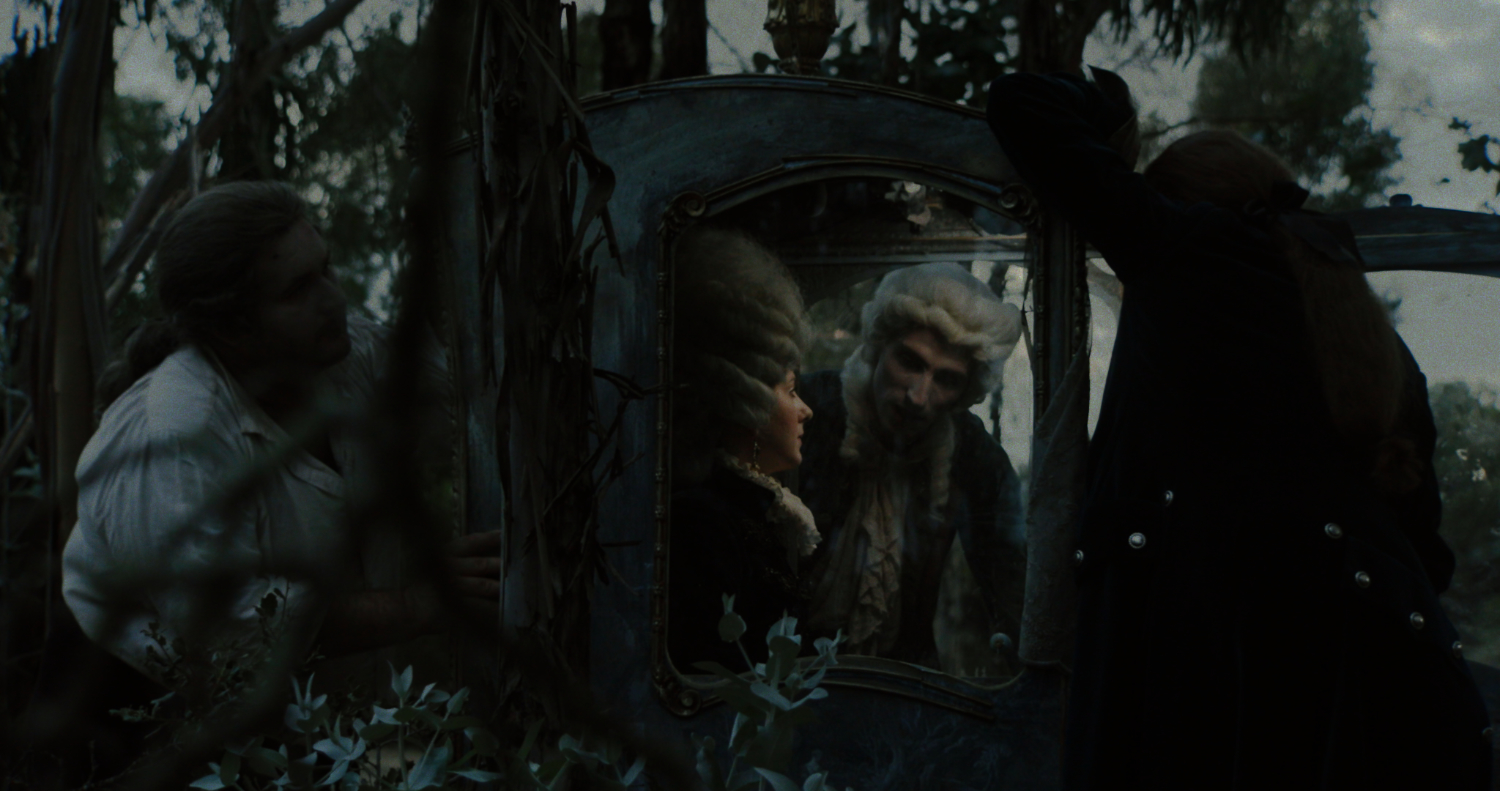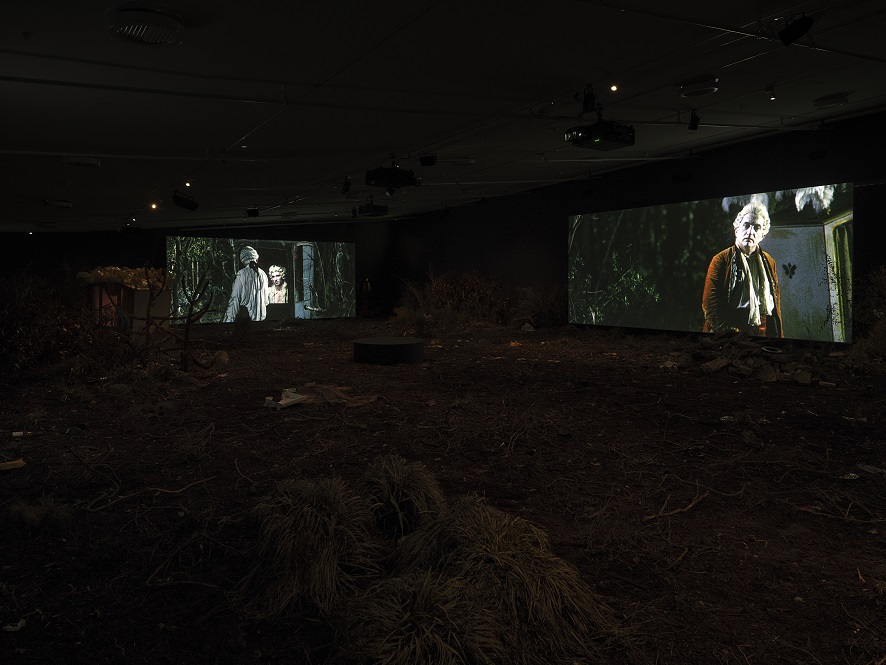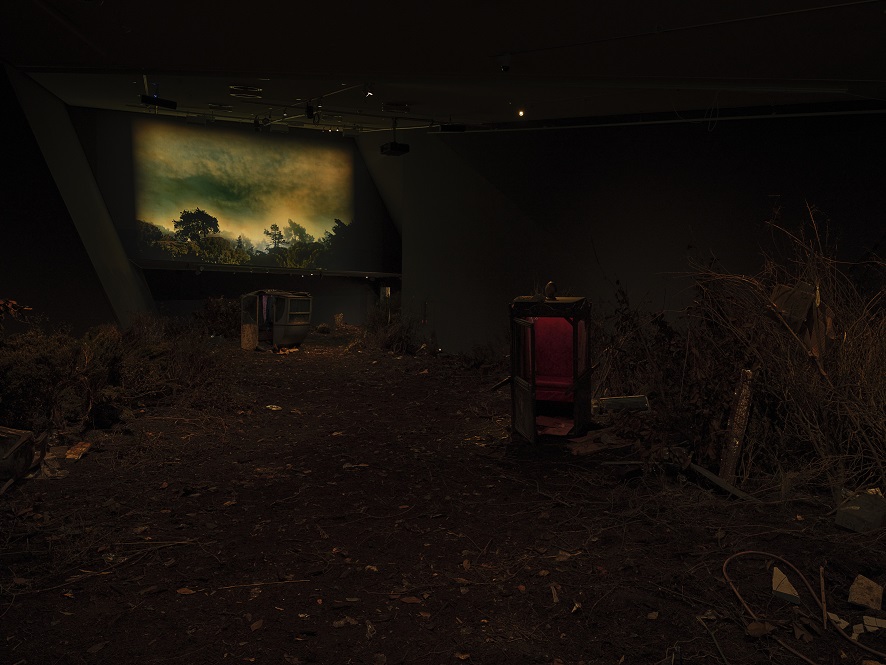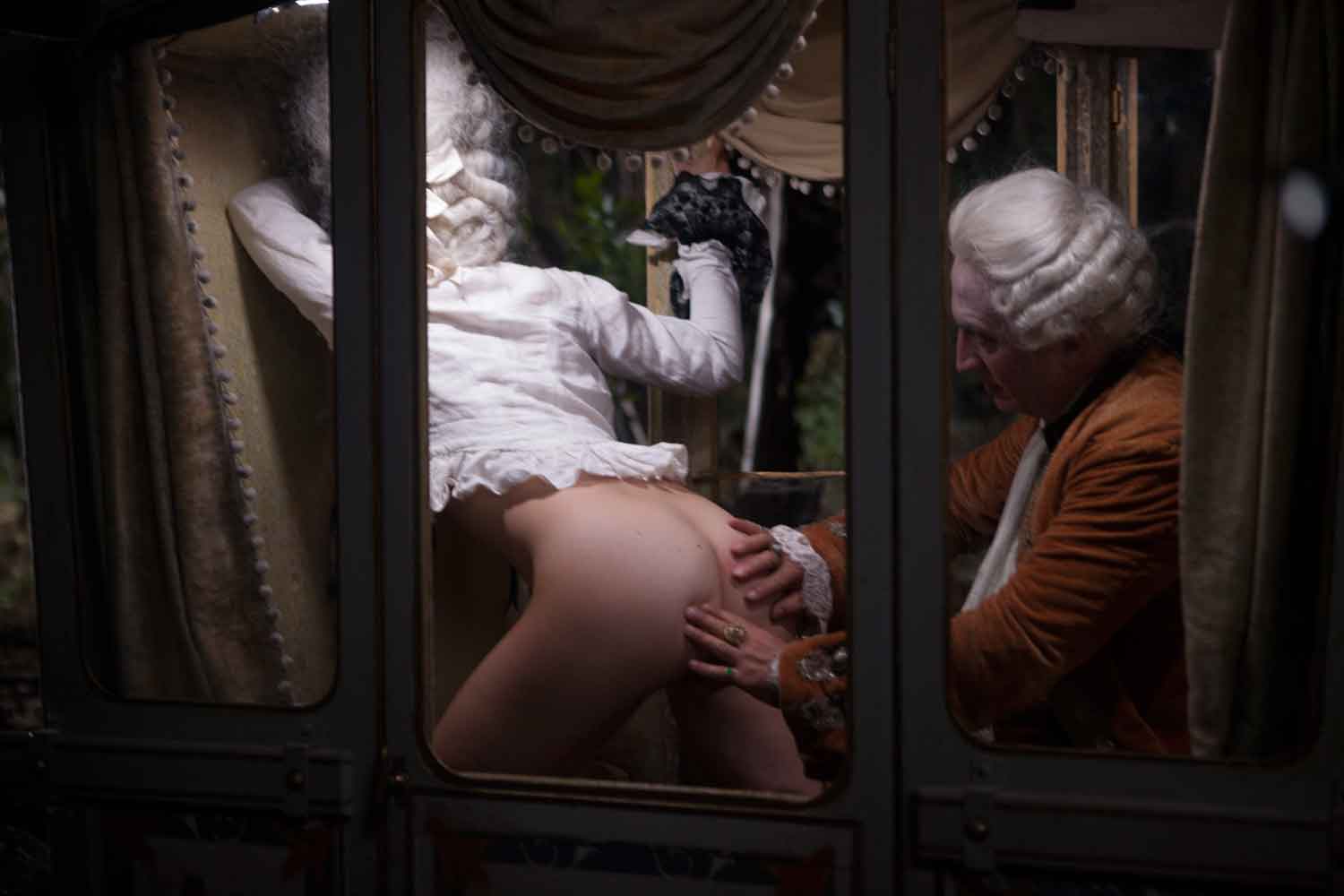Albert Serra Liberté
Eye Filmmuseum
8 June – 29 September 202408-10-2024
For anyone who has heard Albert Serra speak about his films and filmmaking more broadly, it might seem overly generous to describe him as helping to elucidate the paradoxes fundamental to cinema as an art form. Paradoxically indeed, here is a filmmaker who describes what he hates about film, and especially its second-rate status to literature, all while producing a body of work which is invigoratingly cinematic. In the midst of Serra’s aspersions on the “vulgarity” of “popular” cinema and statements like “fuck the spectator,” his films zoom in (often quite literally) on the intimacies and indignities of life within constructed plots, high-falutin historical drama and the contradictory ideologies of statecraft. In his films’ production (where Serra is known to provide scant information to actors or to otherwise direct them through an earpiece) and in their strange, slow narrative structures (full of red herrings and digressions), Serra ultimately encourages a more subversive engagement with cinema’s inherent tension between reality and artifice.
During the opening events for the new and expansive multi-channel installation “Albert Serra: Liberté” (2024) at the Eye Filmmuseum in Amsterdam this summer, Serra’s enfant terrible mode was on full display as he held court with uninterruptible, stream-of-consciousness soliloquies. In conversation with the film scholar and critic Erika Balsom, Serra dominated and drew nervous laughter from the audience with provocative statements: “I never learned anything from anybody,” “humanism isn’t interesting or cinematographic,” “I am the world’s greatest editor… maybe second greatest.” Yet in the midst of this bluster, Serra also described with sensitivity aspects central to his practice, such as how a lack of rehearsal time and the resulting tenderness onscreen related to his fascination with a kind of open space similar to the gaps between chapters of a novel. This could be understood as locating the reader (or viewer, or visitor) within the material—a sign of their immersion in a narrative. While “Liberté” the exhibition was not as delicate or ineffable as the space between book chapters—the installation was huge and nearly pitch black except for a handful of large illuminated screens—it was certainly immersive and situated the viewer as a vital, sensuous link between different parts of the work.

Serra has been working with the material of Liberté since 2018, first as a controversial stage play at Die Volksbühne in Berlin. An equally controversial and critically polarizing feature film Liberté (2019) followed, as did a two-channel video installation at Reina Sofia in Madrid. “Liberté” the exhibition brings together the same set of circumstances as these previous iterations: an intimate crew of 18th-century Libertines, exiled from the court of Louis XVI, meet in a night-time forest clearing to perform—sometimes cautiously, sometimes shockingly—their carnal (and apparently political) desires. The exhibition drops us directly into this scene and into a blanket of darkness that accentuates the sounds of the night air, the chirping crickets and movement among the branches—intermittently punctuated by gasps and moans of pleasure and pain. This soundtrack entices us further into the immense space and into an expanded version of the mise-en-scène, re-imagined here as a cross between a Rococo painting and a contemporary “cruising zone.” A bumpy soil terrain has been spread wall to wall, set with dispersed clumps of shrubbery to hide behind or peek through, assorted unnatural debris (old tires, soda cans, ticket stubs) and two abandoned coaches transported from the film set. These beautifully crafted artifacts, their doors open, dare us to break the norms of exhibition viewing and enter the small enclosures where the film’s debauchery seemingly took place. That the visitor is immediately thrown into a destabilizing darkness means that the installation’s four screens, showing alabaster or moonlit bodies (breasts, buttocks, a recurring leather-sheathed cock), offer a stabilizing force, or at least an illuminated respite from our fumbling, drawing us toward and in between the unfolding action.
These screens, nestled in the larger scenic design and set on all opposing walls, present a thirty-minute edit condensing many of the feature film’s most heightened scenes: the synchronized and slow over-the-pants rubbing; courtesans stripped and whipped or strung up to a tree and doused with copious amounts of milk; an erotic exegesis on an anus. The action across the different screens is synced, offering seamless, sequential, nearly panoramic coverage of sadomasochistic acts interspersed with moments of bystanders looking on, mirroring our own gaze. Serra’s consistent use of three simultaneous cameras not only makes this aforementioned coverage possible, it constructs a sense of a delimited space that we are placed in the midst of. Even as the already minimal dialogue has been all but removed, a curious forward momentum (sometimes rollicking, sometimes languid) develops around and through us. Though actually shot outdoors at night in a eucalyptus forest in Portugal (not “Prussia,” as the narrative dictates), the frontal, artificial lighting accentuates the performativity of the Libertine theatrics, while preserving an improvisational rhythm between actors. This particular mix of artifice and intimacy extends into our own space, where the gallery feels like a soundstage (is one) even as it performs as experiential and expanded cinema.

The exhibition indeed goes to great lengths to produce a world of immersion—with the trucked in tons of dirt, the real garbage and real trees in the service of an all-encompassing sensorium. Even a scent designed especially for Liberté, a sort of a body-meets-earth-meets-Comme des Garçons, is piped into the space to transport us by piquing yet another sense. However, it is through the gaps or ruptures in the smooth surface of immersion that the work opens up to let us in and to reveal its own construction. In Serra’s films and especially in Liberté, the gaps—between the scene and the stage, the artificial and the real—become questions that are central to understanding the work as a whole.
While an immersive sensorial experience is foregrounded from the moment we enter the space, in fact, it is the act of looking—“part of a voyeuristic game” as the wall text points out—that is presented as the primary tension of the exhibition. Liberté unleashes a logic of the night, where the Libertines are free to roleplay and to fuck. The logic of the night pervades the movie theater too, where, protected by darkness, we can safely fulfill our scopophilia—our sense of visual pleasure. The voyeur’s gaze, however, objectifies from a distance: here is a collection of naked and sexualized subjects, engaged in explicit sexual acts, not part of our world, but accessible to us through our private, anonymized gaze. This separation between us and the object of our looking is at odds with the supposedly immersive exhibition setting of the night time cruising zone. Immersion assumes not distancing (by way of dislocation or mediation), but an immediate corporeal experience as the ground of spectatorship. A not uninteresting paradox between voyeurism and immersion arises here, one neither resolved nor even acknowledged by the exhibition framing. The spectator role, however important to the logic of the exhibition, inevitably short circuits because the expectation that we remain separate or external to the scene is consistently eroded by our presence in a surrounding dramaturgy.
Viewing Liberté strictly from a personal subject position will only lead to compromised or frustrated interpretations. Such interpretations were showcased in the Dutch-language press, where several writers began their reviews with naive, bordering on aghast, first-person accounts: “Maybe I should turn back, there’s no one here, perhaps they forgot to switch on the lights. But you never know with modern art, so I shuffle on.”¹ An easy resolution is also not granted by approaching the work strictly on the level of content, as the visitor is met with an immense ambiguity in regard to the characters and the art historical scene. If, however, we approach this exhibition not primarily as a subjective experience, but instead as a formal construction—an exhibition made up of parts brought into relation with one another, despite incompatibility—it becomes apparent that Liberté presents us with a problem of reading. How do we read when we are simultaneously involved in, as well as distanced from, the thing being read?

Two peripherally placed but pivotal elements of the exhibition demonstrate the manner in which voyeurism and immersion are not only experiential modes, but forms that Serra works to destroy from within. The first is encountered halfway into the installation, where closed double doors separate the main space from a side-room that you can only peek into through two small, circular windows. Through these windows can be glimpsed three projections of pornographic scenes: snippets of film reels selected by Serra from the Eye archives from different time periods. The depicted sex is plain, overt, apparent. One film from the 1920s contains a simple plot that finds a nun, a monk and a gardener engaged in a happenstance threesome outdoors; another, from porn’s “golden age” of the 1970s shows a classic close-up of the mechanics of sexual intercourse. It could be said that this porn room positions us into the most literal expression of voyeurism: through a peephole our unidirectional sightline gives us access to imagery that arouses pleasure in us, while keeping us protected by a closed door. This private scopophilic impulse, however, is not maintained for long, as only a simple turn of our bodies puts us back into the cruising zone, amidst a panorama of Liberté on all sides, all sucking in and shooting out a multiplicity of eyelines. The singularity of a voyeur’s subjective view is exploded into a clash of mirrors.
The second component looms over the cruising zone: a fifth screen hung up high, close to the entrance and separate from the other screens. Narrower and feathered around the edges, this screen frames the forest as a distant landscape—the tops of trees under a night sky heavy with an imminent storm. Here our immersive world includes a representation of itself, but imaged as such, all it really shows are the dynamics that hang above our world, moving at a pace so slow as to be easily mistaken for stillness. Midway through the sequence, a sudden burst of lightning appears, revealing to the observant viewer that this apparent painting is actually a moving image. The ensuing rainstorm, heard throughout the space, also appears across the four main screens, where the Libertine’s activities are interrupted as they retreat to their coaches for cover. As lighting strikes and the screen reveals itself to be a projection, a function beyond mere representation becomes apparent, something more akin to a metronome or a clock. The entire cruising zone under the fifth screen, which marks the time by visual shifts, is held together as one timespan and one place: one immersive sensorium. This zone plays out like a theme park ride, not a seamless infinite loop, but a repeating 30-minute go-around; its beginning, middle and end marked by clear cues. Dawn arrives only briefly at the very end of the circle, dispersing the Libertines as the sun begins to rise and the house lights in the gallery come on. All five screens and the porn room go blank, leaving us standing exposed and bleary eyed in an illuminated open space for less than a minute, abandoned yet touched by an awareness of ourselves as integral to the larger performance of the space—only to return straight back into the night. The liberating aspect of Liberté is not a “relinquishing of self control” as the exhibition text puts it, but Serra’s simultaneous construction and destruction of immersion—presented through a veil of raunchy historical and political forms and then undone by theatrics.

Liberté appears to offer an immediate and emboldened sense of ourselves and our bodies in space, demanding that we give into its construction even as it “evokes psychological and moral ambivalence.” It was therefore not surprising that for every visitor cautiously navigating the scene, another would come trundling through the gallery, camera flashlight ablaze, searching—ostensibly—for some kind of traction. In the dark, however, Serra is already showing us everything he wants us to see: human eyes and camera eyes, onlookers and spectators, ambiguous images and immersive reality—reflection, projection, performance, interpretation. This plethora of visions cutting into and bouncing off each other also surrounds a type of violence, where objectification is abundant, order explodes and the lithe, young women onscreen seem oddly matched with the assortment of older, gnarlier men. And though it may be overly generous (once again) to say that Serra is sensitive to these things, he’s certainly not abstracting them. Liberté is not a political work making a statement about a world ideologically, it is a work of images and experiences at once deceptively smooth and challengingly ruptured. Serra makes it our task to hold them together.
- Gawie Keyser, “Onder de hoepelrok,” De Groene Amsterdammer, Nr. 26, June 2024, https://www.groene.nl/artikel/onder-de-hoepelrok.